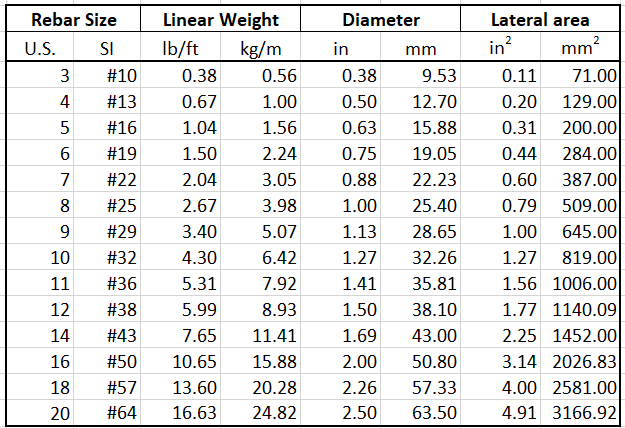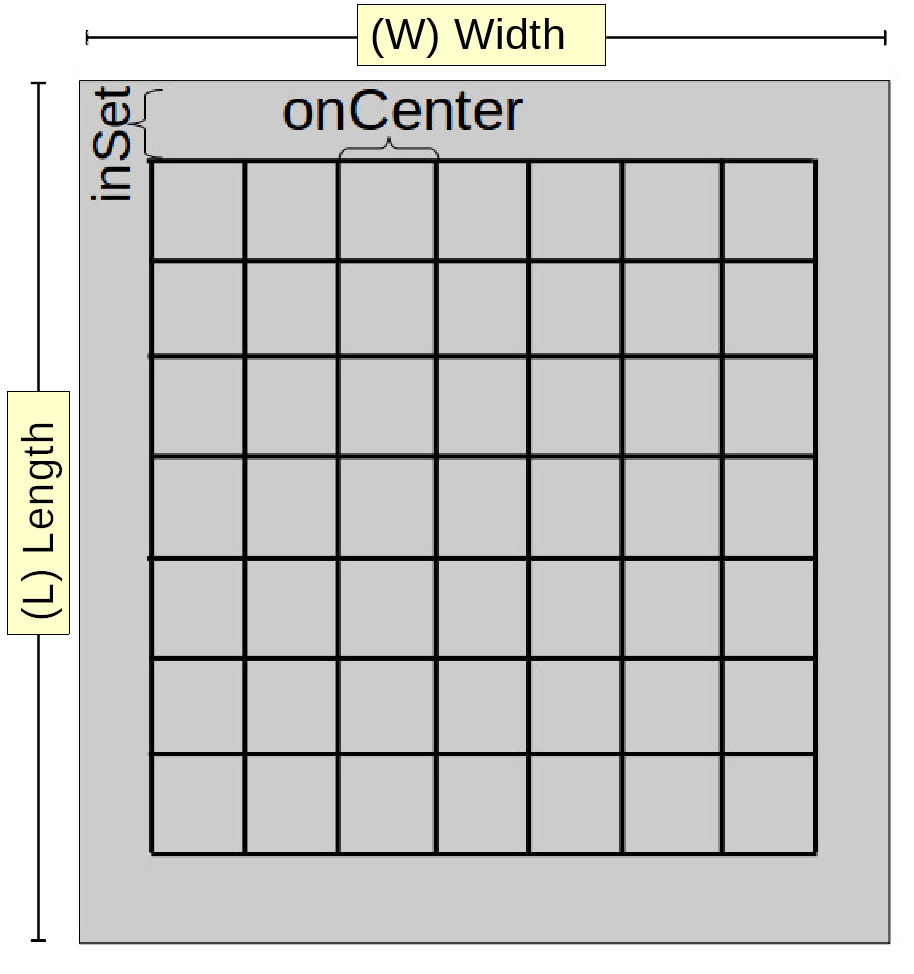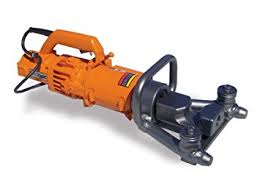Rebar Size Collection
Rebar Size
| Current Rebar Price Estimate | 2025-04-02 |
|---|---|
| 20' Size 5 Rebar Stick | $11.61 USD |
| 20' Size 4 Rebar Stick | $12.26 USD |
Rebar is short for Reinforcement Bar or Barras de Refuerzo in Spanish. Rebar is used in concrete to substantially add strength to the concrete. Rebar adds two strength components. The first is that the steel in rebar expands and contracts at a different rate than concrete. This introduces an opposing expansion force in the concrete structure. The second force is related to the tensile strength of steel that is added to the concrete form.
Rebar comes in different sizes. In the United States the sizes are specified from size 2-11, 14 and 18. The table below shows the specifications of the different sizes of rebar including:
- diameter of the rebar
- weight per linear foot of rebar.
- surface area (lateral area) of the cross-section of the rebar. , where the radius (r) is half of the diameter (d).


Rebar is laid out in a concrete slab as a grid (mat) of bars aligned horizontally and vertically with regular spacing (on center spacing). This is shown in the graphic to the right. Furthermore, the rebar grid is placed several inches from the edge of the slab. This is the inset. Finally, there may be multiple mats (layers) of rebar. Length of Rebar: Once you know the dimensions of your slab (length and width) and the spacing, inset and number of mats, one can calculate the length of rebar needed in a concrete slab (CLICK HERE). The only subtly in the length of rebar is when one considers what's known as lapping (see below). Otherwise, it's a matter of geometric spacing. Weight of Rebar: Once you know the length of rebar in a grid, it is easy to compute the weight of rebar in a grid (CLICK HERE). The weight is simply the length of rebar times the weight specification for the rebar size being used (see table above).
Lapping
When the dimensions of a slab or wall exceed the length of a single piece of rebar, it is required to lap bars and tie them to create the added length. This is called Lapping, and the length of the overlapping rebar is the Lapping Length (CLICK HERE). The length of the lap is specified by a "Lapping Factor (LF)", often 40, which is multiplied to the diameter of the rebar size to compute the Lapping Length . Note: 60 is also a common lapping factor, but the engineering specifications should always be applied. See these YouTube videos to better understand rebar lap:
The typical length of pre-cut rebar is 40' and 60' in the United States.
Rebar Tools
For rebar to be placed in a grid, there are several tools that are commonly used including:


- Rebar Cutter
- Rebar Tier
- Rebar Bender
Here are pictures of some of the mentioned tools
Data Items
- Size 2 Rebar Weight KurtHeckman Use Data Item
- Size 3 Rebar Weight KurtHeckman Use Data Item
- Size 4 Rebar Weight KurtHeckman Use Data Item
- Size 5 Rebar Weight KurtHeckman Use Data Item
- Size 6 Rebar Weight KurtHeckman Use Data Item
- Size 7 Rebar Weight KurtHeckman Use Data Item
- Size 8 Rebar Weight KurtHeckman Use Data Item
- Size 9 Rebar Weight KurtHeckman Use Data Item
- Size 10 Rebar Weight KurtHeckman Use Data Item
- Size 11 Rebar Weight KurtHeckman Use Data Item
- Size 12 Rebar Weight KurtHeckman Use Data Item
- Size 14 Rebar Weight KurtHeckman Use Data Item
- Size 16 Rebar Weight KurtHeckman Use Data Item
- Size 18 Rebar Weight KurtHeckman Use Data Item
- Comments
- Attachments
- Stats
Just found your rebar calculator and I'm trying to figure out the total cy of rebar that would be in a given area. our slabs are 373'x 100' and your calculator says we would have 38,118 lf of #4 rebar, I find the area of a #4 rebar is 0.19635. What is the total cy of rebar in the slab? |
JerryK, The Volume or Displacement of Rebar Calculator (https://www.vcalc.com/wiki/rebar%20displacement) computes 1.925 cubic yards of displacement associated with 38,118 liner feet of size 4 rebar. |
